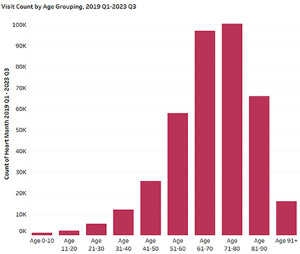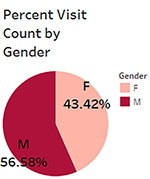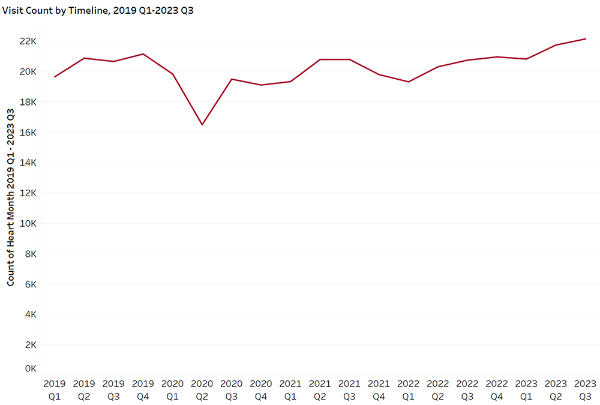Vol. 68, Issue 6
View more issues of The Valued Voice
Sign Up for WHA's Newsletter
Click here to view past issues
IN THIS ISSUE
- WHA Foundation Launches Statewide Workforce Campaign
- Bipartisan Group of U.S. Senators Release 340B Sustain Act Discussion Draft
- Join Us at the Second Annual Health Care Quality Showcase on Advocacy Day 2024
- Zimpel Joins WHA’s Quality Team
- Share Your Hospital's Quality Improvement Stories
- RHeSUS Lunch and Learn Series – Cannabis Webinar Feb. 19
- Fast Facts from the WHA Information Center: February is American Heart Month
EDUCATION EVENTS
Dec. 16, 2025
Common Hospital DeficienciesJan. 14, 2026
Caring for Wisconsin’s Caregivers Well-Being First Champion Challenge for Credentialing KickoffJan. 28, 2026
2026 WHA Health Care Leadership AcademyClick here to view education event calendar
View more issues of The Valued Voice
Sign Up for WHA's Newsletter
Thursday, February 8, 2024

 February is known as American Heart Month, bringing awareness to cardiovascular health. The Centers for Disease Control and Prevention (CDC) states that heart disease is the leading cause of death for both men and women. One person dies every 33 seconds in the U.S. from cardiovascular disease. About 700,000 people in the United States died from heart disease in 2021—that is 1 in every 5 deaths (CDC, 2021). Coronary artery disease is the most common type of heart disease with about 1 in 20 adults aged 20 and older having it. In 2021, 375,000 people died from coronary artery disease. In the U.S., someone has a heart attack approximately every 40 seconds. Heart disease is the leading cause of death for people of most racial and ethnic groups. These statistics bring to light how serious and prevalent heart disease is in this country.
February is known as American Heart Month, bringing awareness to cardiovascular health. The Centers for Disease Control and Prevention (CDC) states that heart disease is the leading cause of death for both men and women. One person dies every 33 seconds in the U.S. from cardiovascular disease. About 700,000 people in the United States died from heart disease in 2021—that is 1 in every 5 deaths (CDC, 2021). Coronary artery disease is the most common type of heart disease with about 1 in 20 adults aged 20 and older having it. In 2021, 375,000 people died from coronary artery disease. In the U.S., someone has a heart attack approximately every 40 seconds. Heart disease is the leading cause of death for people of most racial and ethnic groups. These statistics bring to light how serious and prevalent heart disease is in this country.
 The WHA Information Center (WHAIC) analyzed heart disease claims from all places of service from January 2019 through September 2023. The age group with the highest number of visits is 71-80, followed closely by the age group 61-70. The average age of a patient visiting with a heart disease related condition is 68 years old, but it is important to note that heart disease can happen at any age. High rates of blood pressure and obesity among younger people puts them at higher risk for heart disease earlier in life. Based on WHAIC data, men have a higher visit count for heart disease-related visits than women. Heart disease, however, is the leading cause of death for women in the U.S. The past four quarters of data indicate a higher number of visits for heart disease in Wisconsin hospitals than seen in the years before.
The WHA Information Center (WHAIC) analyzed heart disease claims from all places of service from January 2019 through September 2023. The age group with the highest number of visits is 71-80, followed closely by the age group 61-70. The average age of a patient visiting with a heart disease related condition is 68 years old, but it is important to note that heart disease can happen at any age. High rates of blood pressure and obesity among younger people puts them at higher risk for heart disease earlier in life. Based on WHAIC data, men have a higher visit count for heart disease-related visits than women. Heart disease, however, is the leading cause of death for women in the U.S. The past four quarters of data indicate a higher number of visits for heart disease in Wisconsin hospitals than seen in the years before.
 Here are some risk factors for heart disease from the CDC:
Here are some risk factors for heart disease from the CDC:

Fast Facts from the WHA Information Center: February is American Heart Month

 February is known as American Heart Month, bringing awareness to cardiovascular health. The Centers for Disease Control and Prevention (CDC) states that heart disease is the leading cause of death for both men and women. One person dies every 33 seconds in the U.S. from cardiovascular disease. About 700,000 people in the United States died from heart disease in 2021—that is 1 in every 5 deaths (CDC, 2021). Coronary artery disease is the most common type of heart disease with about 1 in 20 adults aged 20 and older having it. In 2021, 375,000 people died from coronary artery disease. In the U.S., someone has a heart attack approximately every 40 seconds. Heart disease is the leading cause of death for people of most racial and ethnic groups. These statistics bring to light how serious and prevalent heart disease is in this country.
February is known as American Heart Month, bringing awareness to cardiovascular health. The Centers for Disease Control and Prevention (CDC) states that heart disease is the leading cause of death for both men and women. One person dies every 33 seconds in the U.S. from cardiovascular disease. About 700,000 people in the United States died from heart disease in 2021—that is 1 in every 5 deaths (CDC, 2021). Coronary artery disease is the most common type of heart disease with about 1 in 20 adults aged 20 and older having it. In 2021, 375,000 people died from coronary artery disease. In the U.S., someone has a heart attack approximately every 40 seconds. Heart disease is the leading cause of death for people of most racial and ethnic groups. These statistics bring to light how serious and prevalent heart disease is in this country. The WHA Information Center (WHAIC) analyzed heart disease claims from all places of service from January 2019 through September 2023. The age group with the highest number of visits is 71-80, followed closely by the age group 61-70. The average age of a patient visiting with a heart disease related condition is 68 years old, but it is important to note that heart disease can happen at any age. High rates of blood pressure and obesity among younger people puts them at higher risk for heart disease earlier in life. Based on WHAIC data, men have a higher visit count for heart disease-related visits than women. Heart disease, however, is the leading cause of death for women in the U.S. The past four quarters of data indicate a higher number of visits for heart disease in Wisconsin hospitals than seen in the years before.
The WHA Information Center (WHAIC) analyzed heart disease claims from all places of service from January 2019 through September 2023. The age group with the highest number of visits is 71-80, followed closely by the age group 61-70. The average age of a patient visiting with a heart disease related condition is 68 years old, but it is important to note that heart disease can happen at any age. High rates of blood pressure and obesity among younger people puts them at higher risk for heart disease earlier in life. Based on WHAIC data, men have a higher visit count for heart disease-related visits than women. Heart disease, however, is the leading cause of death for women in the U.S. The past four quarters of data indicate a higher number of visits for heart disease in Wisconsin hospitals than seen in the years before. Here are some risk factors for heart disease from the CDC:
Here are some risk factors for heart disease from the CDC:- High blood pressure: High blood pressure is a medical condition where the pressure of the blood in your blood vessels is too high, which then affects your heart and other major organs.
- High Cholesterol: Consuming more cholesterol than the body needs creates extra cholesterol that builds up in the walls of the arteries, including those of the heart. This leads to narrowing of the arteries and can decrease the blood flow to the heart, brain, kidneys and other parts of the body.
- Smoking: Cigarette smoke damages the heart and blood vessels, nicotine raises blood pressure and carbon monoxide from smoke reduces the amount of oxygen carried in the blood, all of which increase the risk of heart disease.
- Obesity: This is an excess of body fat that can lead to high blood pressure and diabetes.
- Diabetes: Having diabetes can cause a buildup of sugar in the blood, which increases the risk of death from heart disease.

Vol. 68, Issue 6
Thursday, February 8, 2024
Fast Facts from the WHA Information Center: February is American Heart Month

 February is known as American Heart Month, bringing awareness to cardiovascular health. The Centers for Disease Control and Prevention (CDC) states that heart disease is the leading cause of death for both men and women. One person dies every 33 seconds in the U.S. from cardiovascular disease. About 700,000 people in the United States died from heart disease in 2021—that is 1 in every 5 deaths (CDC, 2021). Coronary artery disease is the most common type of heart disease with about 1 in 20 adults aged 20 and older having it. In 2021, 375,000 people died from coronary artery disease. In the U.S., someone has a heart attack approximately every 40 seconds. Heart disease is the leading cause of death for people of most racial and ethnic groups. These statistics bring to light how serious and prevalent heart disease is in this country.
February is known as American Heart Month, bringing awareness to cardiovascular health. The Centers for Disease Control and Prevention (CDC) states that heart disease is the leading cause of death for both men and women. One person dies every 33 seconds in the U.S. from cardiovascular disease. About 700,000 people in the United States died from heart disease in 2021—that is 1 in every 5 deaths (CDC, 2021). Coronary artery disease is the most common type of heart disease with about 1 in 20 adults aged 20 and older having it. In 2021, 375,000 people died from coronary artery disease. In the U.S., someone has a heart attack approximately every 40 seconds. Heart disease is the leading cause of death for people of most racial and ethnic groups. These statistics bring to light how serious and prevalent heart disease is in this country. The WHA Information Center (WHAIC) analyzed heart disease claims from all places of service from January 2019 through September 2023. The age group with the highest number of visits is 71-80, followed closely by the age group 61-70. The average age of a patient visiting with a heart disease related condition is 68 years old, but it is important to note that heart disease can happen at any age. High rates of blood pressure and obesity among younger people puts them at higher risk for heart disease earlier in life. Based on WHAIC data, men have a higher visit count for heart disease-related visits than women. Heart disease, however, is the leading cause of death for women in the U.S. The past four quarters of data indicate a higher number of visits for heart disease in Wisconsin hospitals than seen in the years before.
The WHA Information Center (WHAIC) analyzed heart disease claims from all places of service from January 2019 through September 2023. The age group with the highest number of visits is 71-80, followed closely by the age group 61-70. The average age of a patient visiting with a heart disease related condition is 68 years old, but it is important to note that heart disease can happen at any age. High rates of blood pressure and obesity among younger people puts them at higher risk for heart disease earlier in life. Based on WHAIC data, men have a higher visit count for heart disease-related visits than women. Heart disease, however, is the leading cause of death for women in the U.S. The past four quarters of data indicate a higher number of visits for heart disease in Wisconsin hospitals than seen in the years before. Here are some risk factors for heart disease from the CDC:
Here are some risk factors for heart disease from the CDC:- High blood pressure: High blood pressure is a medical condition where the pressure of the blood in your blood vessels is too high, which then affects your heart and other major organs.
- High Cholesterol: Consuming more cholesterol than the body needs creates extra cholesterol that builds up in the walls of the arteries, including those of the heart. This leads to narrowing of the arteries and can decrease the blood flow to the heart, brain, kidneys and other parts of the body.
- Smoking: Cigarette smoke damages the heart and blood vessels, nicotine raises blood pressure and carbon monoxide from smoke reduces the amount of oxygen carried in the blood, all of which increase the risk of heart disease.
- Obesity: This is an excess of body fat that can lead to high blood pressure and diabetes.
- Diabetes: Having diabetes can cause a buildup of sugar in the blood, which increases the risk of death from heart disease.

IN THIS ISSUE
- WHA Foundation Launches Statewide Workforce Campaign
- Bipartisan Group of U.S. Senators Release 340B Sustain Act Discussion Draft
- Join Us at the Second Annual Health Care Quality Showcase on Advocacy Day 2024
- Zimpel Joins WHA’s Quality Team
- Share Your Hospital's Quality Improvement Stories
- RHeSUS Lunch and Learn Series – Cannabis Webinar Feb. 19
- Fast Facts from the WHA Information Center: February is American Heart Month

